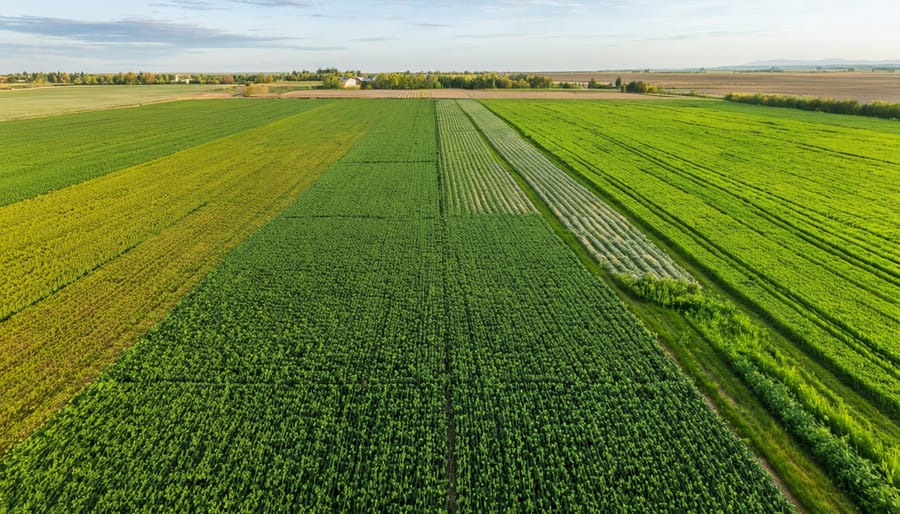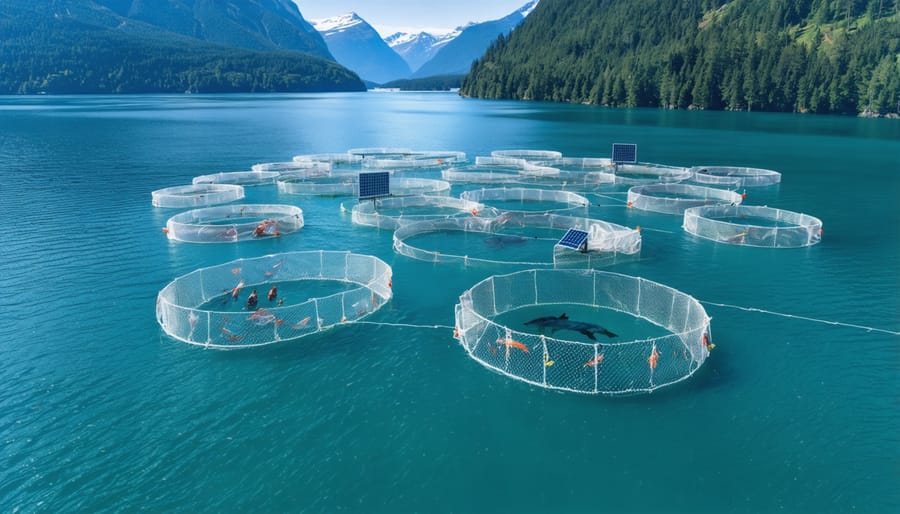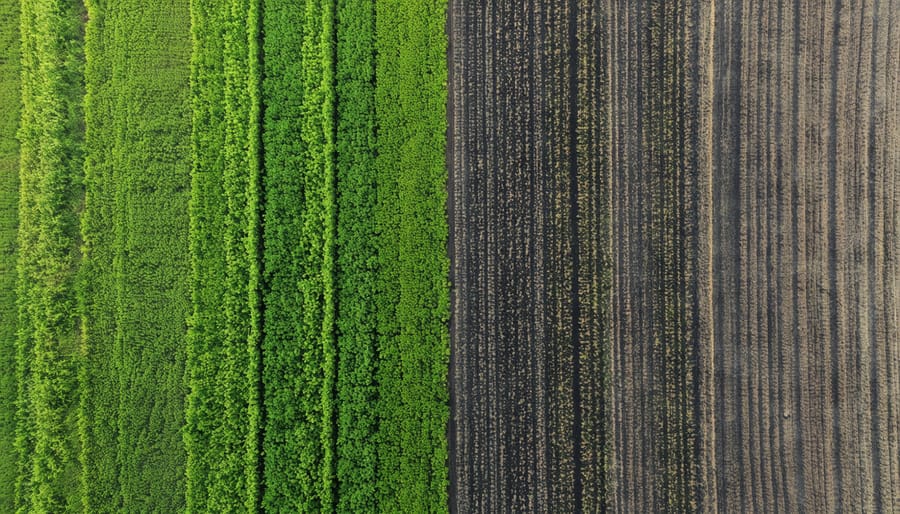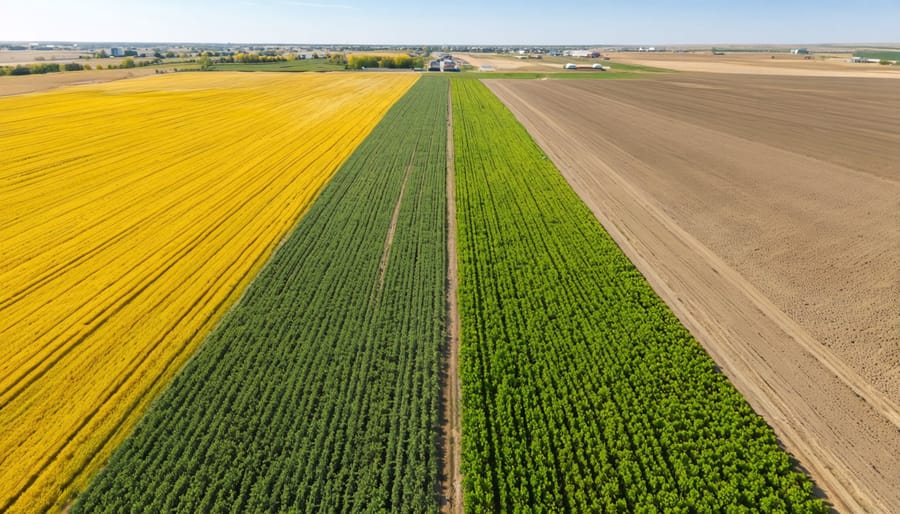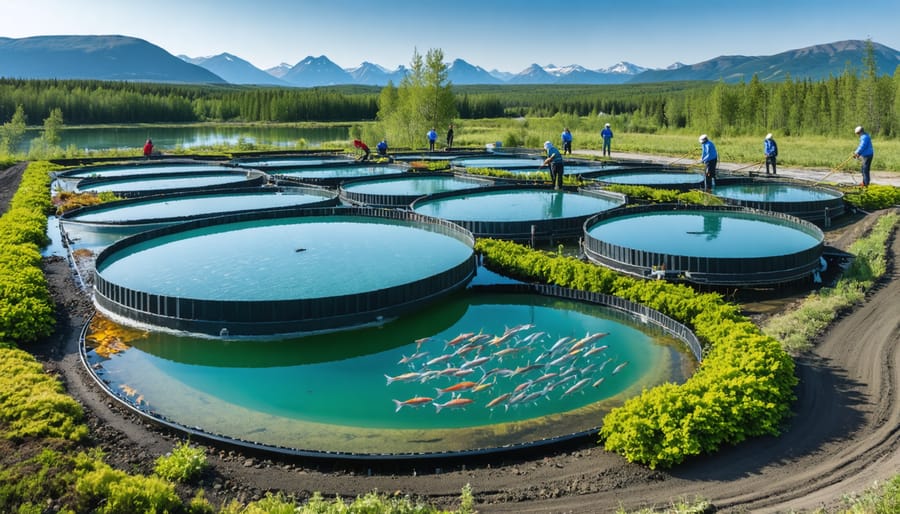Every forkful of food on your table represents an intricate journey of nutrients cycling through soil, plants, animals, and back again—a dance that prairie farmers have both witnessed and shaped for generations. Yet on many Canadian operations, this natural cycle has been interrupted. Nitrogen, phosphorus, and potassium that once flowed seamlessly through integrated farm systems now arrive in bags and leave in grain trucks, creating a costly one-way street that drains both bank accounts and soil health.
The opportunity sitting in front of Alberta farmers is substantial: by closing these nutrient loops on your operation, you’re not just reducing fertilizer bills by 30-50%—you’re building soil organic matter, improving water retention during our increasingly unpredictable growing seasons, and creating resilience against input price volatility.
Understanding nutrient cycles isn’t abstract science—it’s recognizing that the manure from your cattle operation contains the exact nutrients your cereal crops need, that cover crops can capture atmospheric nitrogen worth $200 per acre, and that composted crop residues return minerals to fields rather than burning them off. This circular approach mirrors how prairie ecosystems functioned for millennia before intensive agriculture, and progressive farmers across Western Canada are proving it works economically at commercial scale. The question isn’t whether nutrient cycling matters, but how quickly you can implement these practices to strengthen your operation’s foundation.
What Really Happens to Nutrients on Your Farm
The Natural Flow: From Soil to Plate and Back
Think of your farm as a living bank account where nutrients flow rather than disappear. On a healthy Alberta mixed operation, this cycle starts when crops pull nitrogen, phosphorus, and potassium from the soil through their roots. A canola plant might draw 80-100 kg of nitrogen per hectare during the growing season, converting it into seeds rich with protein and oil.
When cattle graze those fields or eat harvested crops, they don’t destroy those nutrients—they transform them. About 80% of the nitrogen consumed passes through as manure, becoming available again. A beef cow produces roughly 12 tonnes of manure annually, returning valuable organic matter and nutrients to the land.
Here’s where the circle closes: applied properly to fields, that manure feeds soil microbes that break down organic material, releasing nutrients in plant-available forms. Earthworms and bacteria become your unpaid workforce, processing what animals leave behind. The same nitrogen atom might cycle from soil to wheat to cattle and back to soil multiple times across a decade.
Consider the Jansen family near Lacombe, who’ve integrated their grain and cattle operations for three generations. By rotating cattle through crop stubble and applying composted manure strategically, they’ve reduced synthetic fertilizer needs by 40% while maintaining yields. Their soil organic matter has climbed from 3.2% to 4.8% over fifteen years—each percentage point representing thousands of dollars in stored nutrients working for them, not against them.
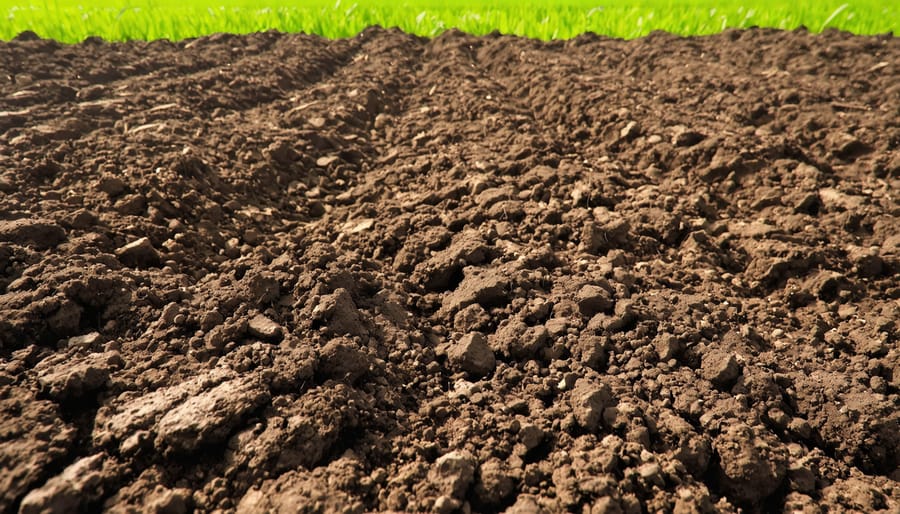
Where the Cycle Breaks: The Real Cost of Linear Systems
On Canadian farms, nutrients slip away through predictable pathways—each representing both environmental loss and economic cost. When you harvest 100 tonnes of canola, approximately 200 kg of nitrogen, 80 kg of phosphorus, and 50 kg of potassium leave your fields. Livestock sales compound this: each market-weight steer removes roughly 15 kg of nitrogen and 8 kg of phosphorus from your operation.
Erosion and runoff create less visible but equally significant losses. Prairie farms experiencing moderate erosion (5-10 tonnes per hectare annually) can lose 25-50 kg of nitrogen per hectare each year. Spring runoff events carry dissolved nutrients into waterways, with some Alberta operations losing up to 30% of applied fertilizers before crops can utilize them.
The financial impact adds up quickly. At current fertilizer prices, replacing exported nutrients through commercial inputs costs prairie grain farmers $150-$250 per hectare annually. For a 500-hectare operation, that’s $75,000-$125,000 leaving the farm each year. Unlike closed-loop farming systems that capture and recycle these nutrients, linear approaches require continuous external inputs—a cycle of dependency that erodes both soil health and profitability over time.
Closing the Loop: Practical Strategies for Alberta Farmers
Start Simple: Composting and Manure Management
Transforming farm waste into valuable nutrients starts with mastering two foundational practices: composting and strategic manure management. These time-tested methods form the backbone of effective farm waste management while reducing input costs.
**Getting Started with Composting**
Begin small with a designated 3m x 3m composting area. Layer carbon-rich materials (straw, wood chips) with nitrogen-rich materials (green plant matter, manure) in a 3:1 ratio. Turn your pile every two weeks during growing season, maintaining moisture similar to a wrung-out sponge. In Alberta’s climate, active composting happens best from May through September. A properly managed pile reaches 55-65°C, killing weed seeds and pathogens within 4-6 weeks.
**Manure Management for Prairie Conditions**
Alberta’s freeze-thaw cycles require strategic timing. Store manure on an impermeable pad with proper drainage to prevent nutrient runoff during spring melt. Apply aged manure (6+ months old) at rates of 20-40 tonnes per hectare for cropland, or 10-20 tonnes per hectare for pasture, depending on soil tests.
“We reduced our fertilizer bills by 40% once we started treating manure as a resource rather than waste,” shares Tom Hendricks, a Red Deer County beef producer who soil-tests annually to fine-tune application rates.
**Application Best Practices**
Apply composted materials in spring when soil temperatures reach 10°C, incorporating within 24 hours to minimize nitrogen loss. For fall applications, wait until soil temperatures drop below 10°C to prevent nutrient leaching. Always conduct soil tests before and after application to track nutrient levels and adjust rates accordingly—this data-driven approach ensures you’re building soil health without over-applying.
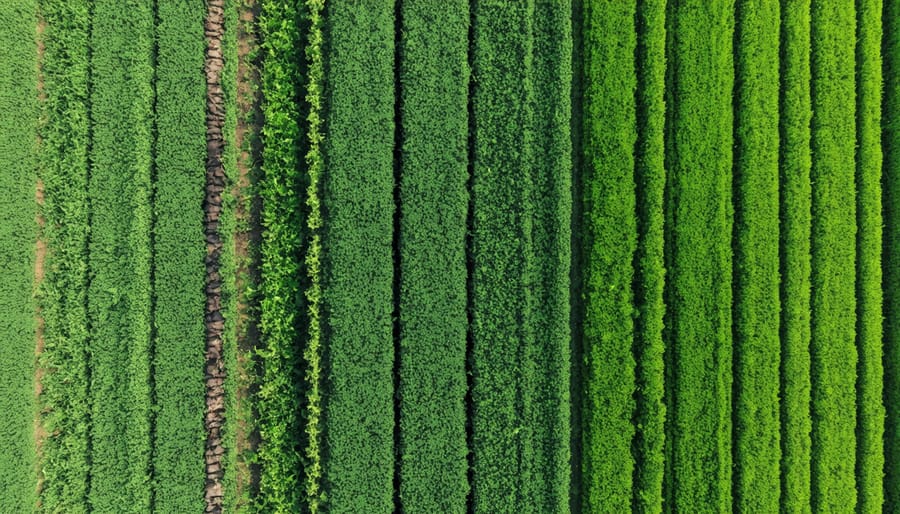
Cover Crops That Work in Short Growing Seasons
Alberta’s short growing season demands strategic cover crop selection, but several species have proven their worth in capturing nutrients and building soil health even with limited frost-free days.
**Fast-Growing Champions**
Annual ryegrass and oats top the list for Alberta producers. These quick germinators establish within 7-10 days and can accumulate significant biomass—up to 2,500 kg per hectare—before the first hard frost. “We’ve seen oats scavenge 40-50 kg of nitrogen per hectare in just 60 days,” explains Dr. Reynald Lemke, soil scientist with Agriculture and Agri-Food Canada’s Lethbridge Research Centre. “That nitrogen would otherwise leach into groundwater over winter.”
**Cold-Tolerant Performers**
Fall rye stands out as the hardiest option, surviving Alberta winters and resuming growth in early spring. This extended growing period allows it to capture an additional 30-40 kg of nitrogen before termination. Winter-hardy peas and hairy vetch, while slower to establish, fix atmospheric nitrogen—potentially adding 70-100 kg per hectare to your nutrient cycle.
**Strategic Mixes**
Many Alberta farmers find success with combinations. A popular mix pairs oats (60%) with fall rye (30%) and hairy vetch (10%). The oats provide quick biomass and erosion protection, the rye survives winter for spring nutrient scavenging, and vetch adds nitrogen fixation.
**Timing for Success**
Seeding immediately after harvest—ideally by mid-August—maximizes growth before frost. Even late September plantings can establish enough root mass to prevent erosion and capture residual nutrients. John Peterson’s Ponoka farm demonstrates this perfectly: his post-wheat oat covers consistently germinate by Labour Day, providing 45 days of active growth before freeze-up.

Integration: Combining Crops and Livestock
Bringing livestock back onto crop land represents one of the most effective ways to tighten nutrient cycles on Canadian farms. When animals graze cover crops or crop residues, they transform plant material into valuable manure right where it’s needed, eliminating transportation costs and nutrient losses that occur with conventional manure management.
Mixed crop-livestock operations across Alberta are rediscovering these benefits. At Benchmark Farm near Red Deer, cattle graze cover crop cocktails planted after wheat harvest. The animals convert the biomass into manure while trampling remaining plant material into the soil, jumpstarting decomposition. Owner Sarah Mitchell reports she’s reduced purchased fertilizer by 30% over three years while improving soil organic matter from 3.1% to 3.8%.
Mob grazing—where high densities of cattle graze small paddocks for short periods—maximizes nutrient distribution. Near Lethbridge, the Henderson family runs 200 cow-calf pairs through their cropland in fall, moving them daily across 0.4-hectare paddocks. This intensive grazing deposits approximately 90 kilograms of nitrogen per hectare, with most remaining in the top 15 centimetres where crops can access it.
The key is timing. Grazing when soils are firm enough to prevent compaction but before freeze-up allows manure to begin breaking down. Many Alberta farmers find late September through October ideal, depending on conditions.
Start small with one field to learn how animals interact with your cropping system, then expand as you gain confidence managing this integrated approach.
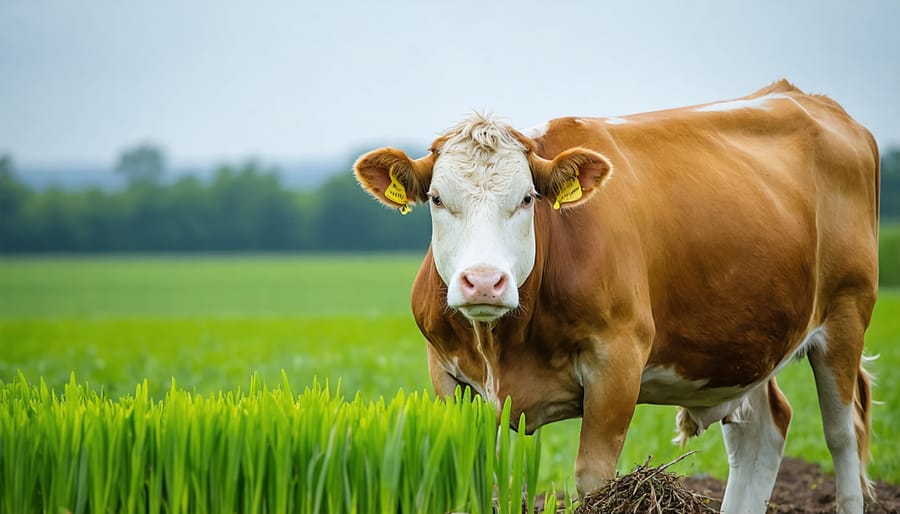
Protecting What You Have: Reducing Nutrient Loss
Prairie soils face unique challenges—wind erosion can strip away topsoil in hours, while spring snowmelt causes significant runoff. Protecting the nutrients you’ve built up requires strategic defenses tailored to these conditions.
**Windbreaks** offer multi-season protection. Shelterbelts reduce wind erosion by up to 80% within a distance of 10 times the tree height. Manitoba farmer Tom Reimer reports his shelterbelts also trap snow, adding an extra 25 millimetres of soil moisture annually—moisture that carries nutrients to his crops rather than across the township road.
**Conservation tillage** keeps crop residue on the surface, acting as armor against both wind and water erosion. Studies from Lethbridge Research Centre show no-till systems reduce phosphorus loss by 60-70% compared to conventional tillage. Initial equipment costs range from $15,000-$40,000, but most Alberta producers see payback within 3-5 years through reduced fuel and labour costs.
**Grassed buffer strips** along drainage areas filter runoff before it leaves your field. A 10-metre buffer can capture 50% of sediment-bound nutrients. Alberta’s Environmental Farm Plan offers cost-share programs covering up to 70% of establishment costs—typically $800-$1,200 per acre initially, with minimal maintenance afterward.
The Economics of Keeping Nutrients Home
Calculating Your Nutrient Investment
Understanding your nutrient investment starts with a simple farm audit. Begin by calculating your annual fertilizer expenses—most Canadian prairie farmers spend $100-$200 per acre on inputs. Next, estimate what leaves your farm: if you’re exporting 150 bushels of canola per acre, you’re removing approximately 135 kg of nitrogen, 27 kg of phosphorus, and 18 kg of potassium with each harvest.
Here’s a practical framework: multiply your fertilizer costs by the percentage that typically leaves your field unused (often 30-50% depending on application timing and weather). This represents your immediate loss. Then consider organic matter depletion—each 1% decline in soil organic matter equals roughly $400 per acre in lost nutrient-holding capacity.
A central Alberta grain farmer discovered through soil testing that precision application could reduce nitrogen loss by 20%, saving $15,000 annually on his 800-acre operation. Start with soil testing in representative field zones, track manure applications if available, and monitor crop removal rates. The highest-value opportunities typically emerge where nutrient applications don’t match crop uptake timing or where organic amendments could offset synthetic inputs.
What Alberta Farmers Are Saving: Real Numbers
Alberta grain and livestock operations are seeing measurable returns from closing their nutrient loops. At Clearview Farms near Red Deer, integrating cattle manure into their wheat-canola rotation reduced synthetic fertilizer costs by $45 per acre while maintaining yields above regional averages.
“We’ve cut our nitrogen bill nearly in half,” says farm manager Tom Hendricks. “The soil testing shows we’re building organic matter at the same time—from 2.8% to 3.4% in just four years.”
A 2023 study by Alberta Agriculture tracked 27 mixed farms implementing nutrient cycling practices. These operations reduced fertilizer expenses by an average of $12,000 annually while increasing soil carbon by 0.15% per year. Most reported improved water retention during drought periods.
Near Lethbridge, dairy producer Sarah Chen uses composted manure and cover crops together. “My phosphorus applications dropped 60%,” she notes. “The real win is consistency—we’re not seeing the yield swings we used to during variable weather.”
Economic data confirms these aren’t isolated cases. Alberta farms actively recycling nutrients through manure management and cover cropping average 8-12% lower input costs compared to conventional operations, with comparable or better yields over five-year periods.
Overcoming Common Obstacles
Working With Alberta’s Climate Reality
Alberta’s climate presents unique challenges for nutrient cycling, but smart farmers are turning these constraints into opportunities. Our short growing season (typically 100-120 frost-free days) means timing is everything—organic matter breaks down more slowly in cool soils, so fall applications of compost often work better than spring additions, giving materials time to decompose before planting.
Cold winters actually offer advantages. Freezing and thawing cycles naturally break down crop residues and help incorporate organic matter into soil structure. Many producers use winter months to apply manure on frozen ground, reducing compaction while building soil reserves for spring.
Variable precipitation requires adaptive planning. In drier years, focus on moisture-conserving practices like maintaining crop residues as mulch—they’ll slowly release nutrients while protecting soil. Wetter seasons allow for more aggressive green manure crops like fall rye or winter wheat that scavenge leftover nutrients before spring thaw.
Successful Alberta operations combine these climate adaptation strategies with careful monitoring. Soil testing in both spring and fall helps track nutrient availability and adjust management accordingly. The key is working with our climate’s rhythm rather than against it.
Finding Support and Knowledge in Your Community
You don’t have to navigate nutrient cycling alone. Alberta’s agricultural community offers extensive support for farmers transitioning to sustainable practices. Start with Alberta Agriculture and Irrigation’s regional offices, where agrologists provide free consultations on soil health and nutrient management specific to your operation’s conditions.
Olds College and the University of Alberta host regular workshops on composting, cover cropping, and integrated nutrient strategies throughout the growing season. Many are available online, making them accessible regardless of your location. The Alberta Soil Health Network connects farmers experimenting with regenerative practices, offering peer-to-peer learning opportunities and field days where you can see nutrient cycling in action.
Provincial agronomists can conduct soil tests and interpret results within your farm’s context, helping you develop tailored nutrient management plans. Organizations like the Agricultural Research and Extension Council of Alberta (ARECA) fund on-farm research projects, allowing you to test nutrient cycling approaches with expert guidance and financial support.
Connect with your local watershed stewardship groups—they often provide cost-share programs for beneficial management practices that improve nutrient retention. Fellow farmers remain your best teachers; don’t hesitate to reach out to neighbors successfully implementing these practices. Their real-world experience complements technical expertise and builds the community knowledge that strengthens everyone’s operations.
Building Your Farm’s Nutrient Future
Starting your journey toward better nutrient cycling doesn’t require overhauling your entire operation overnight. Begin with one field or practice, observe the results, and build from there.
**Start with Assessment**
Walk your fields and identify where nutrients are leaving your farm—through erosion, runoff, or products sold. Consider what organic matter you’re already producing: crop residues, livestock manure, or cover crop biomass. This baseline helps you understand your current nutrient flows and spot immediate opportunities.
**Choose One Practice**
Select a single change that fits your operation. Prairie farmers often start with reduced tillage to keep organic matter in place, or plant a simple cover crop like fall rye after harvest. Livestock producers might begin by composting manure instead of applying it fresh, capturing more nutrients and reducing runoff potential. Each small step builds skills and confidence.
**Connect with Your Community**
Join a local producer group or connect with Alberta’s agricultural service boards to learn from neighbours who’ve already tested regenerative agriculture practices. These relationships provide troubleshooting support and shared equipment access, making transitions more manageable.
**Think in Rotations, Not Seasons**
Plan nutrient improvements across three to five years. This timeframe allows soil biology to respond and gives you room to adjust practices based on weather patterns and market conditions. Track simple metrics like soil organic matter tests every few years to document progress.
**Build Climate Resilience**
Better nutrient cycling improves water retention and soil structure—critical advantages during Alberta’s increasingly variable weather patterns. Fields with higher organic matter weather both droughts and heavy rains more successfully, protecting your productivity long-term.
Remember, every farm’s nutrient future looks different. Focus on continuous improvement rather than perfection, and celebrate the incremental gains that compound into significant change.
Keeping nutrients cycling on your operation isn’t just good for the environment—it’s a smart business decision that puts you in control of your input costs while building soil health for future generations. Every manure application, cover crop, or composting system you implement reduces your dependence on external fertilizers and strengthens the resilience of your land. The economic benefits are real: farmers across Alberta are already seeing reduced input costs, improved soil structure, and better crop performance by closing their nutrient loops.
You don’t need to transform your entire operation overnight. Start with one practice that fits your current setup—whether that’s better manure management, introducing a simple cover crop, or connecting with a neighbouring livestock producer. The beauty of nutrient cycling is that small changes create momentum, and every step you take builds on the last.
The Canadian agricultural community is here to support you. Reach out to your local extension office, join a producer group, or simply talk to a neighbour who’s already implementing these practices. Your soil, your bottom line, and your community will benefit. Take that first step today—your farm’s future depends on the cycles you create now.


